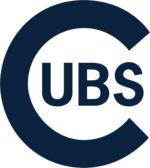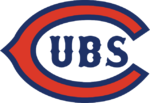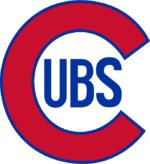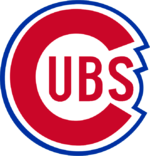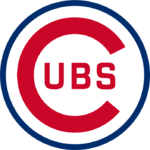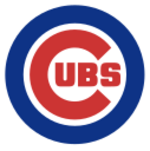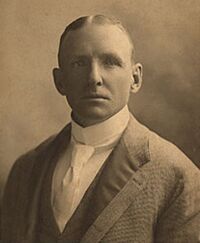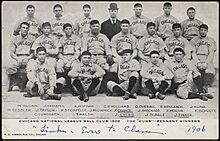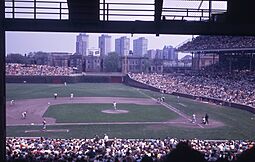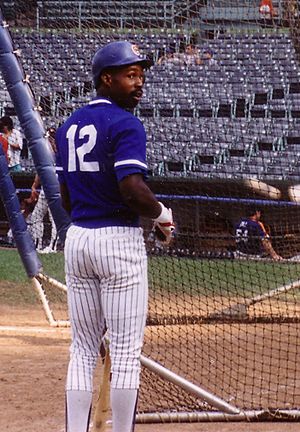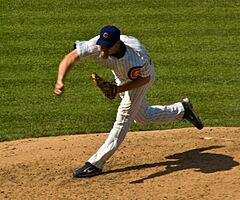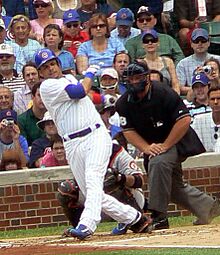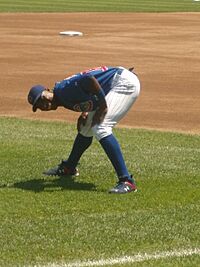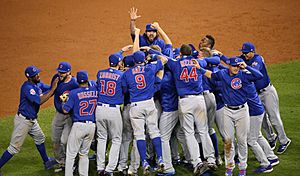History of the Chicago Cubs facts for kids
The Chicago Cubs are a famous baseball team in Major League Baseball. They are one of the oldest professional sports teams in North America. The team started playing in 1870 as the Chicago White Stockings. They are the only team to play in the same city since the National League began in 1876. Over the years, they were called different names like White Stockings, Orphans, and Colts. In 1907, they officially became the "Cubs."
Contents
Early Years: White Stockings and Colts
1870: The Chicago White Stockings
In the late 1860s, baseball became very popular. Many professional teams started up. The Chicago team was officially called "The Chicago Base Ball Club." Because their uniforms were white, reporters started calling them the "White Stockings."
On April 29, 1870, the White Stockings played their first game. They easily beat the Union Club of St. Louis 7–1. That year, Chicago joined the National Association of Base Ball Players. This was the top league at the time. Chicago won the championship, but another team, the New York Mutuals, disagreed.
1871–1875: Building a New League
In 1871, the first all-professional league, the National Association of Professional Base Ball Players, was formed. The White Stockings joined as a founding member. Their home field was the Union Base-Ball Grounds in Lake Park.
Later that year, the Great Chicago Fire destroyed much of the city. The team's ballpark and all their equipment were burned. Despite this, the White Stockings finished their season playing on the road. They ended up in second place. The team had to stop playing for a few years while Chicago recovered. They returned in 1874.
During this time, the Boston Red Stockings dominated the league. William Hulbert, the White Stockings' president, was unhappy with how the league was run. He didn't like that players could easily switch teams. He also worried about gambling. So, Hulbert decided to create a new, stronger league. He convinced other team owners to join him. This new league became the National League of Professional Base Ball Clubs. Its creation meant the end of the old National Association.
1876–1900: The National League Era
After 1875, Hulbert brought in several key players. These included pitcher Albert Spalding and first baseman Adrian Anson. The Chicago National League Ball Club quickly became one of the best teams in the new National League. Spalding won 47 games in 1876. The White Stockings easily won the National League's first championship.
In 1880, the White Stockings had an amazing season. They won 67 games and lost only 17. This gave them a .798 winning percentage, which is still a National League record.
Cap Anson and a Chicago Dynasty
Cap Anson was the team's best player. He became the team captain and was so important that the team was often called "Anson's Colts." Anson led the team to more championships in 1880 and 1881. Pitchers Larry Corcoran and Fred Goldsmith were key players. Corcoran threw three no-hitters. Goldsmith is known for helping invent the curveball.
In 1882, Hulbert passed away. Al Spalding, who had started a sporting goods company, took over the team. Anson became the team's manager.
In 1885, the team moved to a new home, "West Side Park I." They won the National League championship again. The team had a strong infield, known as the "Chicago Stone Wall." Ned Williamson hit 27 home runs in 1884, a record that lasted for many years. John Clarkson won an incredible 53 games in 1885. Anson thought these 1885–86 teams were the best he ever managed.
Anson was the first player to reach 3,000 hits. He also led the league in RBI eight times. His influence on the team was huge. By the mid-1890s, the team was commonly called the Chicago Colts or Anson's Colts.
Anson also played a role in a sad part of baseball history. He refused to play against Black players. This led to a rule that prevented African-Americans from playing in Major League Baseball for many years. This rule, called the "color line," lasted for half a century.
The Colts' success began to fade in the mid-1890s. In 1898, Spalding decided not to renew Anson's contract.
Transition to the Cubs
Baseball's popularity dipped in the 1890s. The Colts moved to a new park, "West Side Park II," in 1893. After Anson left, the team was sometimes called the Remnants or Orphans by the media. The name "Colts" was still used until 1905.
The name "Cubs" first appeared in print in 1902. It became very popular over the next few years. By 1906, it was the main nickname. The team officially recognized it in 1907. The "Cub-in-the-C" logo appeared on uniforms in 1908.
In 1900, a new team on Chicago's south side adopted the old "Chicago White Stockings" name. This team later became known as the Chicago White Sox.
Early MLB Years (Dead-Ball Era)
1901–1913: A New Cubs Dynasty
After the American League formed, Al Spalding sold the Cubs to John Hart in 1902. The team Spalding had built was very strong. Joe Tinker (shortstop), Johnny Evers (second baseman), and Frank Chance (first baseman) were three Hall-of-Fame players. They played together from 1903 to 1912. Along with third baseman Harry Steinfeldt and catcher Johnny Kling, they formed one of the most dominant baseball teams ever.
By 1905, Charles Murphy owned the Cubs. Chance became the manager. The Cubs then won four championships and two World Series titles in five years. Their record of 116 wins in 1906 is still a record for a 154-game season. They also have the best winning percentage of the modern era (.763). However, they lost the 1906 World Series to the White Sox.
The Cubs had amazing pitchers during this time. These included Mordecai "Three-Finger" Brown, Jack Taylor, and Ed Reulbach. Their pitchers had the lowest team earned run average (ERA) in history. Brown got his nickname because he lost part of his index finger as a child. This injury actually helped him put a special spin on his pitches.
In 1907, the Cubs won 107 games. They beat Ty Cobb and the Detroit Tigers 4–1 in the 1907 World Series for their first championship.
On September 23, 1908, a famous play happened. The Cubs and New York Giants were tied in the ninth inning. A Giants runner, Fred Merkle, left the field without touching second base. Cubs player Johnny Evers got the ball and touched second. The umpires called Merkle out, ending the inning and the game as a tie. This play became known as "Merkle's Boner." Because of the tie, the Cubs and Giants ended up tied for first place. The Cubs won a special playoff game. They then beat the Tigers again in the 1908 World Series, winning their second straight championship. This would be their last World Series win for 108 years.
Tinker to Evers to Chance
The Cubs' star infielders, Tinker, Evers, and Chance, became very famous. They were even mentioned in a poem called Baseball's Sad Lexicon in 1910. The poem talked about how they would often turn a double play against opposing teams. The phrase "Tinker to Evers to Chance" is still used today to mean a "well-oiled routine" or a "sure thing."
Tinker and Evers reportedly didn't like each other off the field. The trio didn't play much together after 1911 due to injuries. In 1913, Chance and Tinker left the Cubs. All three were inducted into the Baseball Hall of Fame together in 1946.
1914–1924: New Owners and a Pennant
The Cubs struggled after their stars left. In 1916, Charles Weeghman and Albert Lasker became owners. They moved the Cubs to Weeghman Park, which is now Wrigley Field.
The team became competitive again. They won the National League championship in 1918. In the 1918 World Series, the Cubs faced the Boston Red Sox. Babe Ruth pitched for the Red Sox and helped them win the series. Ruth was later sold to the Yankees, starting a long period of struggles for the Red Sox.
After the 1919 Black Sox Scandal, which involved gambling in baseball, Albert Lasker helped create a new way to run Major League Baseball. Judge Kenesaw Mountain Landis became the first Commissioner of Baseball. By this time, William Wrigley Jr., the chewing gum magnate, had bought more and more stock in the Cubs. By 1921, Wrigley owned the team.
1925–1946: The Wrigley Years
Winning Every Three Years
After buying the team, Wrigley changed the ballpark's name to Wrigley Field in 1925. This helped promote his chewing gum brand. Wrigley also hired William Veeck, Sr. as club president.
With Wrigley's money and Veeck's smart decisions, the Cubs became strong contenders. Players like Hack Wilson, Gabby Hartnett, and Billy Herman joined the team. They achieved something unusual: winning a championship every three years – 1929, 1932, 1935, and 1938. However, they lost to their American League rivals in the World Series each time.
In the 1932 World Series, Babe Ruth of the New York Yankees hit his famous "called shot" home run at Wrigley Field. The Yankees swept the Cubs in four games. The Cubs had some great moments too. In 1935, they won 21 straight games in September. They then played in the 1935 World Series but lost to the Detroit Tigers.
In 1938, player-manager Gabby Hartnett hit a "walk-off" home run in a crucial late-season game. This became known as "The Homer in the Gloamin'." But the Cubs lost to the Yankees again in the 1938 World Series. After this, the team entered a period of less success.
The Curse of the Billy Goat
The Cubs won one more championship in 1945, at the end of World War II. They were led by players like Andy Pafko and Phil Cavarretta. The 1945 World Series started in Detroit, where the Cubs won two games. The series then moved to Wrigley Field.
In Game 4, the famous "Curse of the Billy Goat" began. Philip K. Wrigley asked a fan named Billy Sianis to leave the park. Sianis had brought his goat to the game, and people complained about its smell. When Sianis was asked to leave, he reportedly said, "the Cubs, they ain't gonna win no more." His family said he sent a telegram to Wrigley, saying the Cubs would never win another championship or World Series.
The Cubs lost Game 4. They went on to lose the 1945 World Series in seven games. After this, the Cubs did not win another championship or World Series until 2016. From 1940 to 1992, the Cubs had only 11 winning seasons.
Later Wrigley Years (1947–1981)
1947–1981: The Dark Ages
After the 1945 World Series loss, the Cubs struggled for many years. From 1947 to 1966, they had only two winning seasons. Many of those teams lost over 90 games. In 1962 and 1966, they lost over 100 games. This was despite the great play of shortstop Ernie Banks, known as "Mr. Cub."
In 1960, owner Phil Wrigley tried a new idea. He said the Cubs would no longer have one manager. Instead, an "College of Coaches" would run the team. This experiment didn't work well. There was no clear leader, and the team kept losing. Some talented players like Ron Santo and Billy Williams joined the team during this time. But without steady leadership, the Cubs remained at the bottom of the league. Wrigley finally hired Leo Durocher as a single manager in 1966.
In the mid-1960s, the Cubs started to improve. Banks, Williams, and Santo, along with pitcher Ferguson Jenkins, gave fans hope. In 1967 and 1968, they had winning seasons for the first time in a long while.
Fall of 1969
In 1969, the Cubs started strong. They had a big lead in their division, the newly created National League East. The team was led by Hall of Famers Banks, Jenkins, Santo, and Williams. Jenkins won 21 games. However, the Cubs struggled in September. They lost key games to the New York Mets. They finished eight games out of first place. Many fans blamed this collapse on a black cat that ran onto the field during a game in September. Others thought playing too many day games in the summer heat tired the team out.
1970–1981: Bad Teams and the June Swoon
The 1970s were tough for the Cubs. They had few successful seasons. After 1973, many of their core players retired or were traded. The Cubs sank to the bottom of the National League East. During this time, the term "Loveable Losers" became popular. Fans still came to watch the team, even though they weren't winning much.
Phil Wrigley passed away in 1977. His son, William Wrigley III, took over the team. In 1977, the Cubs had their best start of the decade. They were in first place with a big lead in June. But they collapsed in the second half of the season, finishing with an even record of 81–81.
The team had similar collapses in 1978 and 1979. This pattern of starting strong and then falling in the standings became known as "The June Swoon."
1981–2008: Tribune Company Era
1984 and 1989 NL East Champs
In 1981, the Tribune Company bought the Cubs from the Wrigley family. This was a big change for the team. In 1982, the Cubs traded for shortstop Larry Bowa and infielder Ryne Sandberg.
In 1983, Dallas Green became the general manager. He made several trades to improve the team. He also hired Jim Frey as the new manager.
1984 NL East Champs
The Cubs started the 1984 season well. Green continued to make trades, bringing in pitcher Rick Sutcliffe. On June 23, Ryne Sandberg hit two game-tying home runs in a famous game against the St. Louis Cardinals. This game made him a national star. The Cubs had a great second half of the season.
They finished with 96 wins, the best in the league, and won the NL East Championship. This was their first playoff appearance since 1945. Chicago faced the San Diego Padres in the playoffs. The Cubs won the first two games at home. But they lost the next three games in San Diego, including a close Game 5 where a key error by first baseman Leon Durham helped the Padres win.
In 1985, the Cubs started strong again but then had another "swoon." They lost 13 games in a row. In 1987, outfielder Andre Dawson joined the team. He hit 49 home runs and won the NL MVP award, even though the Cubs finished in last place.
In 1988, lights were installed at Wrigley Field. The first night game was on August 8, but it was rained out. The first official night game was the next day. The Cubs had six All-Stars that year, including Dawson, Sandberg, and Greg Maddux.
In 1989, the Cubs won the NL East again. Young players like first baseman Mark Grace and outfielder Jerome Walton contributed to their success. Walton set a club record with a 30-game hitting streak. This time, Chicago played the San Francisco Giants in the playoffs. The Cubs lost the series in five games.
1990–2002: Ryno, Gracie, and Sammy
Between 1990 and 1997, the Cubs struggled again. Many seasons were over by June. Pitcher Greg Maddux, who won a Cy Young Award with the Cubs, left the team. The team's farm system, which develops young players, didn't produce many good pitchers.
On offense, things were a bit better. Mark Grace, shortstop Shawon Dunston, and catcher Joe Girardi were fan favorites. Ryne Sandberg became the highest-paid player in baseball. Sammy Sosa started to become a powerful home run hitter. But the teams themselves were not very good.
In 1997, the Cubs lost their first 14 games of the season. They finished in last place. Many expected 1998 to be another tough year.
However, 1998 was a special season. The team signed left fielder Henry Rodríguez, closer Rod Beck, and pitcher Kevin Tapani. The season was dedicated to beloved broadcaster Harry Caray, who had passed away. The Cubs got into an exciting Wild Card race. Sammy Sosa had an amazing season, hitting 66 home runs and winning the MVP award. Pitcher Kerry Wood had a dominating rookie year, including a game where he struck out 20 batters. The Cubs made the playoffs but were swept by the Atlanta Braves.
After 1998, the Cubs struggled again in 1999. Manager Jim Riggleman was fired. Andy MacPhail became the new team president. He promised to lead the team to success.
In 2001, the Cubs made another playoff push. They acquired first baseman Fred McGriff. Sammy Sosa had one of his best seasons, hitting 64 home runs and driving in 160 runs. Pitcher Jon Lieber won 20 games. The Cubs were close to winning their division but fell short. They had a very bad season in 2002.
2003–2006: The Dusty Baker Years
In 2003, the Cubs won their first NL Central title. Their success came from a strong group of starting pitchers: Mark Prior, Kerry Wood, Carlos Zambrano, and Matt Clement. All of them won at least 13 games. The team also acquired third baseman Aramis Ramírez and center fielder Kenny Lofton.
The Cubs had a great September, winning 19 out of 27 games. They clinched the division on September 27. They then beat the Atlanta Braves in the playoffs, their first playoff series win since 1908. They moved on to face the Florida Marlins in the championship series. The Cubs took a 3-1 lead in the series. It looked like they would finally reach the World Series.
Game 6, on October 14, was a huge event. Fans packed the streets outside Wrigley Field. The Cubs had a 3–0 lead in the eighth inning. Then, a fan named Steve Bartman tried to catch a foul ball. This interfered with Cubs outfielder Moisés Alou. After this, the Marlins scored 8 runs and won the game. The next night, the Cubs lost Game 7. They were once again left out of the World Series.
In 2004, the Cubs brought back Greg Maddux to join their strong pitching staff. They also traded for star shortstop Nomar Garciaparra. The Cubs had a Wild Card lead in September. But they lost 7 of their last 9 games and missed the playoffs.
In 2005, the Cubs traded Sammy Sosa to the Baltimore Orioles. Derrek Lee had a great season, hitting .335 with 46 home runs. But many key players were injured, and the team finished in fourth place. The White Sox won the World Series that year, which was tough for Cubs fans.
In 2006, the Cubs signed new outfielders Juan Pierre and Jacque Jones. They started the season well, but an injury to Derrek Lee hurt the team. They finished with a very poor record of 66–96. The team's president, Andy MacPhail, resigned. The Cubs decided not to renew manager Dusty Baker's contract.
2007–2008: Back-to-Back Playoff Appearances
After finishing last in 2006, the Cubs went from worst to first in 2007. They hired veteran manager Lou Piniella. The team re-signed Aramis Ramírez and signed pitchers Ted Lilly and Jason Marquis. They also gave Alfonso Soriano the richest contract in Cubs' history. The team started slowly, but then improved. They won 19 games in July. In September, the Cubs won important games and clinched their division.
In the playoffs, they faced the Arizona Diamondbacks. The Cubs lost Game 1 and Game 2. In the final game at home, the Cubs had many chances to score but couldn't. They lost the series, ending another promising season too soon.
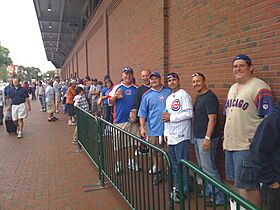
In 2008, the Cubs signed Japanese superstar Kosuke Fukudome. They started the season strong, winning their 10,000th franchise game in April. By mid-June, Chicago had the best record in baseball. Eight Cubs players were named All-Stars. The Cubs traded for star pitcher Rich Harden.
The team overcame a seven-game losing streak in September. Carlos Zambrano pitched the Cubs' first no-hitter in three decades on September 14. The Cubs clinched their second straight division title on September 20. However, the heavily favored Cubs were swept by the Los Angeles Dodgers in the playoffs. This was a disappointing end to a season that many thought would be a "Dream Season."
2009–Present: The Ricketts Family Era
New Ownership and Rebuilding
In 2009, the Ricketts family bought the Cubs from the Tribune Company. This marked a new era for the team. The Cubs signed outfielder Milton Bradley. Key players like Kerry Wood and Mark DeRosa left the team.
The Cubs started well in 2009, but injuries hurt the team. Bradley's poor play and bad attitude also caused problems. Despite this, the Cubs finished with a winning record (83–78) for the third straight year.
In 2010, manager Lou Piniella retired. The Cubs finished in 5th place. Mike Quade became the interim manager and then the full-time manager for 2011. But the 2011 team finished 20 games under .500.
Under New Management and the 2016 World Series Champions
After the 2011 season, Theo Epstein was hired as the club president. He had helped the Boston Red Sox win championships. Epstein brought in Jed Hoyer as general manager and hired Dale Sveum as manager. The team had a very bad season in 2012, losing 101 games. This was part of a plan to rebuild the team with young players. Longtime fan favorite Kerry Wood retired. Young players like Anthony Rizzo became the focus.
After losing records in 2013 and 2014, the Cubs hired Joe Maddon as their new manager. In 2015, the Cubs made the playoffs. They beat the Pittsburgh Pirates and the St. Louis Cardinals but lost to the New York Mets in the championship series.
In 2016, the Cubs had the best record in Major League Baseball, with 103 wins. They won their division for the first time since 2008. In the playoffs, they beat the San Francisco Giants and the Los Angeles Dodgers. This broke the "Curse of the Billy Goat" and sent the Cubs to the World Series for the first time since 1945.
In the 2016 World Series, the Cubs faced the Cleveland Indians. They fell behind 3 games to 1. But they won games five and six to force a Game 7. After ten innings and a rain delay, the Cubs won Game 7 by a score of 8–7. This historic win ended the longest championship drought in American sports history. The Cubs won their third World Series trophy and their first in 108 years!
2017–Present: Post-Championship Years
After winning in 2016, the Cubs tried to win again in 2017. They struggled in the first half of the season but bounced back to win their division. They beat the Nationals in the playoffs but lost to the Dodgers in the championship series.
In 2018, the Cubs signed new pitchers like Yu Darvish and Brandon Morrow. But many players, including Darvish and Kris Bryant, were injured. The Cubs still stayed in first place for most of the season. However, the Milwaukee Brewers tied them for the division title. The Brewers then beat the Cubs in a tie-breaker game. The Cubs lost in the Wild Card game, ending their playoff run early.
In 2019, the Cubs were leading their division in July. But they had a long losing streak in September and missed the playoffs. In 2020, the season was shortened due to the COVID-19 pandemic. The Cubs finished first in their division but were swept in the Wild Card round.
In 2021, the Cubs traded away many key players from their 2016 team. They finished fourth in their division. In 2022, they finished third. In 2023, the Cubs finished second in their division. They then hired Craig Counsell as their new manager.
Retired Numbers
The Chicago Cubs honor retired numbers on flags at Wrigley Field. Jackie Robinson's number 42 is retired for all Major League Baseball teams.
|
Some fans want to retire other numbers, like Gabby Hartnett's, Kerry Wood's number 34, Sammy Sosa's number 21, and Mark Grace's number 17.
Famous Moments and Records
Merkle's Boner

On September 23, 1908, the Cubs and New York Giants were in a close race for the championship. In the ninth inning, a Giants player named Fred Merkle hit a single. But he left the field without touching second base. Cubs player Johnny Evers got the ball and touched second. The umpires called Merkle out, ending the inning and the game as a tie. This play meant the Cubs and Giants finished tied for first place. The Cubs won a special playoff game and went on to the World Series.
Babe Ruth's Called Shot
On October 1, 1932, during Game 3 of the World Series, Babe Ruth of the New York Yankees stepped up to bat. He supposedly pointed to the center field bleachers at Wrigley Field. Then, he hit a long home run to that exact spot. Whether he truly "called" the shot is debated, but it's a famous story. Ruth helped the Yankees win the World Series that year.
Hack Wilson's RBI Record
In 1930, Hack Wilson set a record with 56 home runs and 190 RBI. Later, researchers found an extra RBI, making his record 191 RBI. This record still stands today. No one has come close to breaking it in over 75 years. Wilson's 56 home runs was also a National League record until 1998.
The Homer in the Gloamin'
On September 28, 1938, the Cubs and Pirates were tied 5–5. It was getting dark at Wrigley Field, which didn't have lights yet. With two outs in the bottom of the ninth, player-manager Gabby Hartnett hit a home run into the dim light. This famous hit became known as his "Homer in the Gloamin'." It helped the Cubs win a crucial game.
The Sandberg Game
On June 23, 1984, the Cubs were losing to the St. Louis Cardinals. Ryne Sandberg, known for his great defense, hit a game-tying home run in the ninth inning. The Cardinals scored again in the tenth. But Sandberg came up again and hit another game-tying home run! The Cubs won the game in the 11th inning. This game made "Ryno" Sandberg a household name.
First Night Game at Wrigley Field
On August 8, 1988, the Cubs played their first night game ever at Wrigley Field. Wrigley Field was the last Major League Baseball park to install lights. A lifelong fan named Harry Grossman was chosen to turn on the lights. He said, "Let there be light!" The game was rained out early, so the first official night game was the next day.
Sammy Sosa's Home Run Month
In June 1998, Sammy Sosa had an incredible month. He hit 20 home runs, breaking a record for most home runs in a single month. This helped him get into a famous race with Mark McGwire to break the single-season home run record. Sosa finished the season with 66 home runs and won the NL MVP Award.
The Steve Bartman Incident
On October 14, 2003, the Cubs were leading 3–0 in the eighth inning of a playoff game against the Miami Marlins. A Marlins player hit a foul ball toward the left field wall. A fan named Steve Bartman tried to catch the ball, interfering with Cubs outfielder Moisés Alou. After this, the Marlins scored 8 runs and won the game. They went on to win the series. Bartman faced a lot of criticism from Cubs fans. This incident was highlighted in an ESPN documentary called Catching Hell.
10,000th Win
On April 23, 2008, the Cubs recorded their 10,000th regular-season win. This milestone dates back to the start of the National League in 1876. The Cubs were only the second team in Major League Baseball history to reach 10,000 wins. To celebrate, the Cubs flew a special white flag with "10,000" on it, along with their usual "W" flag.
Tape-Measure Home Runs
Wrigley Field has seen some incredibly long home runs. On May 11, 2000, Glenallen Hill hit a ball onto the roof of a building across Waveland Avenue. This shot was estimated to be over 500 feet. No batted ball has ever hit the center field scoreboard. In 1979, Dave Kingman hit a ball estimated at 555 feet. This is thought to be the longest home run in Wrigley Field history.
Individual Awards
Rookie of the Year
- 1961 – Billy Williams
- 1962 – Ken Hubbs
- 1989 – Jerome Walton
- 1998 – Kerry Wood
- 2008 – Geovany Soto
- 2015 – Kris Bryant
Most Valuable Player
- 1935 – Gabby Hartnett
- 1945 – Phil Cavarretta
- 1952 – Hank Sauer
- 1958 – Ernie Banks
- 1959 – Ernie Banks
- 1984 – Ryne Sandberg
- 1987 – Andre Dawson
- 1998 – Sammy Sosa
- 2016 – Kris Bryant
Cy Young Award (Best Pitcher)
- 1971 – Ferguson Jenkins
- 1979 – Bruce Sutter
- 1984 – Rick Sutcliffe
- 1992 – Greg Maddux
- 2015 – Jake Arrieta
Rivalries
Crosstown Classic: Chicago White Sox
The Cubs and White Sox have a big rivalry because they are both in Chicago. Cubs fans are called "North Siders," and White Sox fans are "South Siders." They play each other in the "Crosstown Classic." The White Sox have won more games in the regular season series.
Milwaukee Brewers
The Brewers-Cubs rivalry grew when the Brewers moved to the National League Central Division in 1998. Their ballparks are less than 85 miles apart. Many Cubs fans travel to Milwaukee to watch games at Miller Park. This is because Miller Park has more seats and a roof, so games are never rained out. This travel by fans makes the rivalry even more intense. Some call Miller Park "Wrigley North."
St. Louis Cardinals
The Cardinals–Cubs rivalry is one of the oldest and most famous in baseball. The Cubs have won more games in their overall series. However, the Cardinals have won more National League championships and World Series titles. The Cardinals have also had more winning seasons than the Cubs.
The two teams have been in the same division for many years. This has led to exciting races for the division title, like in 1984, 1989, 2003, 2004, 2015, and 2016. In 2015, the Cubs made the playoffs as a Wild Card team. They beat the Cardinals in the playoffs but then lost to the New York Mets. In 2016, the Cubs won their division with the best record in baseball. They then beat the San Francisco Giants and the Los Angeles Dodgers to win the National League championship. In the 2016 World Series, the Cubs defeated the Cleveland Indians to end their 108-year championship drought.
Ownership
List of Owners
- 1876: William Hulbert
- 1882: Albert Spalding
- 1902: James Hart
- 1905: Charles Murphy
- 1914: Charles Taft
- 1916: Charles Weeghman/Albert Lasker (part of an investment group)
- 1921: Wrigley and Company (Wrigley family)
- 1981: Tribune Company
- 2007: Sam Zell
- 2009: Family trust of Joe Ricketts; chairman Thomas S. Ricketts





